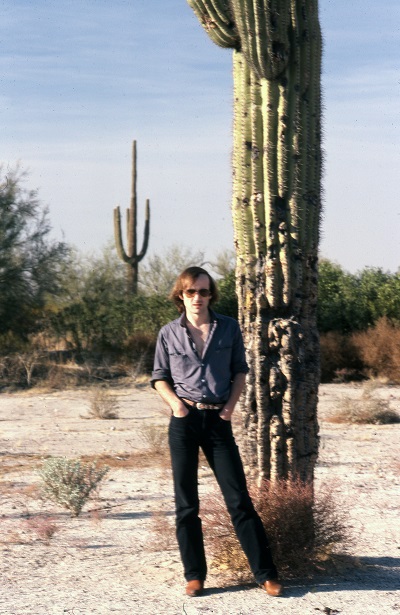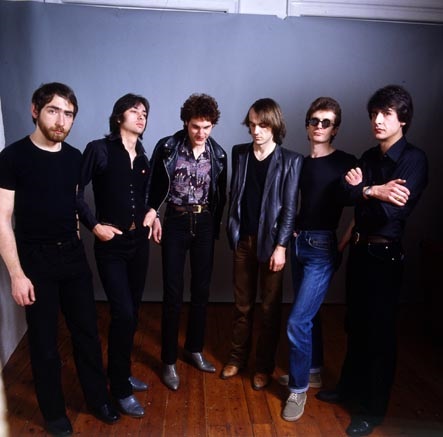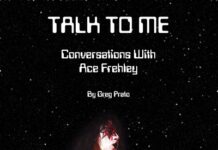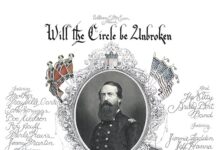Photos Courtesy of Paul Roberts
Their lone U.S. hit begins simply enough until nine seconds in — a few acoustic guitar strums and then POW, the musical gas is punched in the form of a single gunshot-styled snare drumbeat.
This revs things up instantly as the drumming intensifies and cocksure electric guitar riffs join in, followed by a set of gritty vocals that sound simultaneously guarded and vulnerable, all underscored by punctual synthesizer blips.
In 1979, the UK-based Sniff ‘n’ the Tears took the track “Driver’s Seat” all the way to Number 15 on the Billboard Hot 100, despite it sounding tailor-made for the lunatic fringe. I say that because it’s a breakout, one-hit rock song attaining success in a year all-but dominated by Donna Summer. Others to achieve this milestone that same year included Nick Lowe with “Cruel to be Kind” and Ian Gomm with “Hold On.”
The success of the “Driver’s Seat” also propelled the group’s debut album, Fickle Heart, into the U.S. Top 40.
“I think everyone was surprised,” band frontman Paul Roberts told me recently. “It didn’t conform to the obvious tropes, but everyone who heard it seemed to love it so we knew we were onto something. I still couldn’t tell you what.”
The group, which at its height included seven members, would alas never have another hit stateside.
“In some way, (“Driver’s Seat”) established an unrealistic precedent,” Roberts said. “It was a bit of a one-off.”
This is irrelevant. All it takes is 20 lines of primal lyrical intensity and seductive closing guitar and synthesizer solos for the band to leave its cultural mark. Not only has the track been featured in everything from car ads to the hit film Boogie Nights, I also hear the group’s influence in modern independents like The War on Drugs.
Sniff ‘n’ the Tears would go on to release three more albums in quick succession — The Game’s Up (1980), Love/Action (1981), and Ride Blue Divide (1982). While members would filter in and out of the group, the one constant was Roberts — an amalgam of Bob Dylan, Mark Knopfler, and Gerry Rafferty. The year before the group’s major US success, Rafferty, formerly of Stealers Wheel (“Stuck in the Middle with You”), conquered the Billboard charts with both his platinum-selling City To City album and its plaintive yet harrowing hit single “Baker Street.”
It’s Roberts who would help drive the band into the 1980s, culminating in a new wave sound evident on more underrated SNTT tracks like “Hungry Eyes,” “Like Wildfire,” and “The Hand of Fate.”
Sniff ‘n’ the Tears began in 1973, cutting its musical chops on the London pub circuit. After the loss of a guitarist to the military, Roberts was asked to record demos in France for noted record exec Jerry Moss. Roberts agreed, provided he could head home to do so. Back in London, Roberts would meet drummer Luigi Salvoni, at the time playing with a group called Moon. Salvoni would help assemble the musicians who played on the demos, including future Tears Loz Netto (guitar), Mick Dyche (guitar), and Alan Freedman (keyboards). As Roberts described to me, the group recorded roughly 12 tracks in a single afternoon.
“I got back into painting and for a while forgot about music,” Roberts said. “Then one day I got a phone call from Luigi telling me that Moon had broken up and that he had been listening to the French demos and liked them. Would I mind if he took them to a record company he knew. I agreed.”
The label would be the independent Chiswick Records, which immediately offered a deal. The demos were scratched in favor of re-recording the tracks. Other Tears to soon join the fold would be bassist Chris Birkin and synthesizer player Keith Miller.
The result was Fickle Heart about two weeks later.
“Only Luigi and I had signed to the label, everyone else were paid sessions rates,” Roberts said. “Nobody really expected anything to happen and some had their own projects to consider.”
As for the uniqueness of the group’s name — it stems from two unlikely sources.
“I had attempted a dystopian novel which had a band in it called ‘The Tears,’ Roberts said. “My manager at the time suggested Sniff ‘n’ the Tears because I had hay fever and sniffed a lot.”
The album opens mightily with “Driver’s Seat.” Composed by Roberts before his trek to France, the song is — contrary to popular belief — not about driving but rather love had then lost.
“Lyrically, the song is about picking yourself up after a breakup,” Roberts said. “Musically, it started as a riff; behind the riff was a revolving chord sequence. I abandoned the riff when I realized it was a bit similar to something else, but the acoustic pattern was unusual and led to a certain propulsive tension that suited the fragmented state of mind implied by the words.”
While Roberts adds the “Jenny” described in the song’s lyrics is not about a girlfriend at the time, she is still inspired by someone he previously knew. Roberts’ lyrics are near-ominous and pleading in the way he describes the relationship and its subsequent dissolution:
“There is no elite — just take your place in the driver’s seat!”
“Jenny was sweet — there is no relief! Pick up your feet. Pick up, pick up!”
Four minutes of unbridled intensity culminates in a track as mysterious as it is accessible. Upon peaking on the charts in Holland post-band breakup, the group would reunite and unleash new music. Lightning like this doesn’t always strike twice for everybody. The only other lucky recipient I can immediately think of to experience this in roughly the same time period is Benny Mardones. His “Into the Night” hit the Billboard Top 20 on two separate occasions.
But let me take the opportunity to emphasize that the entire Fickle Heart album is worth a listen. “New Lines on Love” is equal parts moody and catchy; “Sing” is more in line with hit songs of the period given its thump-heavy bass beat; “Looking for You” envelops the listener to warmly close out the album.
The group’s single success would prompt a tour of the U.S. in late summer ’79. Sniff would ultimately spend a month supporting Kenny Loggins (post-Nightwatch, pre-Keep the Fire) and a month supporting American prog stalwarts Kansas shortly after the release of their Monolith album.
“A fantastic experience, although now I wouldn’t do it that way,” Roberts said. “I think it’s more important to build your own audience. We should have headlined clubs rather than playing coliseums to someone else’s audience. A journalist in LA rang me to ask why we weren’t playing a club because she had no intention of going to the LA Spectrum for a Kansas gig.”
One hit by Sniff ‘n’ the Tears ultimately yielded eight albums. Today, the group has reformed as an acoustic duo of Roberts and guitarist Les Davidson, who first joined the band in 1980. While the band’s sound has shifted gears some, it’s certainly nice to see they haven’t put the brakes on SNTT activity.
Per Roberts: “As two blokes with acoustic guitars, things look a lot more possible.”

***
Share your feedback and suggestions for future columns with Ira at vinylconfessions84@gmail.com.




















